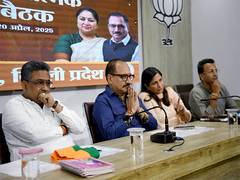Mumbai: Skyscrapers, buildings remain veiled behind haze of smog as air quality recorded poor
Mumbai (Maharashtra) [India], November 7 (ANI): Mumbai’s air quality was recorded as ‘Moderate’ on Tuesday morning with a thick haze of smoke and fog veiling skyscrapers, buildings and other residential areas in the city.
The Air Quality Index (AQI) for Mumbai was recorded at 159 at 1 pm which is considered ‘Moderate’.
Likewise, air quality index at 1 pm in Colaba was recorded at 201 which falls under ‘Poor’ category. in Malad it was was recorded at 200 in Bandra, 233 in Bandra, 118 in Boriavali, 147 in Colaba and 83 in Worli, Kalanagar it was 228. In Chembur it was 302, in Andheri at 125 and in Navi Mumbai it was recorded at 149.
The Bombay High Court on Monday passed interim directions for the Maharashtra government and municipal authorities in Mumbai and surrounding areas to mitigate the issue of worsening air pollution.
The court permitted the busting of fire crackers only for 3 hours, between 7pm to 10pm.
The court was hearing a suo motu public interest litigation on the deteriorating air quality in the Mumbai Metropolitan Region.
It has directed covered trucks to be used for carrying materials to and from construction sites and no carrying of construction debris till November 10. The High Court warned that if the air quality does not substantially improve by then, it may consider passing a total ban on the transportation of construction material till Diwali.
Further, the State government was to consider the measures specified in the judgments of the National Green Tribunal (NGT) and the Supreme Court on firecrackers.
The court also directed strict implementation of air pollution mitigation plan announced by Brihanmumbai Municipal Corporation (BMC) in March this year.
The PM2.5 levels have increased significantly since 2019, with a 54.2 per cent jump in 2020, followed by marginal declines in 2021 and 2022 and a sharp spike of 42.1 per cent in 2023.
The microscopic PM 2.5 particles can lodge deep in the lungs and cause health problems. Lower wind speed and increased humidity led to a thick smog cover over the city.
Experts attribute the dust pollution to cold wind from the Western Ghats mixing with warmer air along the coast.
The current concentration of PM2.5 in Mumbai is 59 (ug/m3).
The World Health Organisation (WHO) recommends 15 ug/m3 as the threshold concentration of PM2.5 for 24 hours. Currently, the concentration is 2.36 times the recommended limit.
Meanwhile, the AQI in Delhi NCR continued to reel under the “severe” category on Tuesday while posing a serious threat to the health of people.
Air pollution levels can be high during the winter months for a number of reasons, including dust and vehicular pollution, dry-cold weather, stubble burning, burning crop residues after the harvest season and commuting.
Cold air is denser and moves slower than warm air, so it traps pollution and doesn’t whisk it away. This means that air pollution in winter remains in place for much longer than during the summer.
According to doctors, for any healthy person, a recommended AQI should be less than 50, but these days the AQI has spiked beyond 400, which could prove fatal for those suffering from lung-related diseases and even poses a risk of lung cancer.






